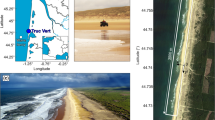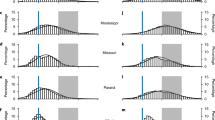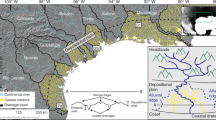Abstract
Linear sand dunes—dunes that extend parallel to each other rather than in star-like or crescentic forms—are the most abundant type of desert sand dune1. But because their development and their internal structure are poorly understood, they are rarely recognized in the rock record2. Models of linear dune development2,3,4,5,6 have not been able to take into account the sub-surface structure of existing dunes, but have relied instead either on the extrapolation of short-term measurements of winds and sediment transport or on observations of near-surface internal sedimentary structures. From such studies, it has not been clear if linear dunes can migrate laterally2,7,8. Here we present images produced by ground penetrating radar showing the three-dimensional sedimentary structure of a linear dune in the Namib sand sea, where some of the world's largest linear dunes are situated. These profiles show clear evidence for lateral migration in a linear dune. Moreover, the migration of a sinuous crest-line along the dune produces divergent sets of cross-stratification, which can become stacked as the dune height increases, and large linear dunes can support superimposed dunes that produce stacked sets of trough cross-stratification. These clear structural signatures of linear dunes should facilitate their recognition in geological records.
This is a preview of subscription content, access via your institution
Access options
Subscribe to this journal
Receive 51 print issues and online access
$199.00 per year
only $3.90 per issue
Buy this article
- Purchase on Springer Link
- Instant access to full article PDF
Prices may be subject to local taxes which are calculated during checkout




Similar content being viewed by others
References
Lancaster, N. Linear dunes. Prog. Phys. Geogr. 6, 475– 504 (1982).
Rubin, D. M. & Hunter, R. E. Why deposits of longitudinal dunes are rarely recognised in the geologic record. Sedimentology 32, 147–157 (1985)
Bagnold, R. A. The Physics of Blown Sand and Desert Dunes (Methuen, London, 1941).
McKee, E. & Tibbitts, G. C. Jr Primary structures of a seif dune and associated deposits in Libya. J. Sedim. Petrol. 34, 5–17 (1964).
McKee, E. Sedimentary structures in dunes of the Namib desert, South West Africa. Geol. Soc. Am. Spec. Pap. 188, 64 ( 1982).
Tsoar, H. Internal structure and surface geometry of longitudinal seif dunes. J. Sedim. Petrol. 52, 823–831 (1982).
Hesp, P., Hyde, R., Hesp, V. & Zengyu, Q. Longitudinal dunes can move sideways. Earth Surf. Processes Landforms 14, 447–451 (1989).
Rubin, D. M. Lateral migration of linear dunes in the Strzelecki Desert, Australia. Earth Surf. Processes Landforms 15, 1– 14 (1990).
Livingstone, I. Monitoring surface change on a Namib linear dune. Earth Surf. Processes Landforms 14, 317–332 ( 1989).
Bristow, C., Pugh, J. & Goodall, T. Internal structure of aeolian dunes in Abu Dhabi determined using ground penetrating radar. Sedimentology 43, 995–1003 (1996).
Lancaster, N. Geomorphology of Desert Dunes (Routledge, London, 1995 )
Tsoar, H. Dynamic processes acting on a longitudinal (seif) sand dune. Sedimentology 30, 567–578 ( 1983).
Rubin, D. M. & Hunter, R. E. Bedform alignment in directionally varying flows. Science 237, 276– 278 (1987).
Acknowledgements
We thank the staff of DRFN at Gobabeb for their assistance and logistical support without which this project would not have been possible; the Namibian Ministry of Environment and Tourism for permission to undertake research within the Namib Naukluft National Park; and D. Upton for his assistance in the field and for drafting the figures. This work was supported by the NERC; S.D.B. thanks the NERC for a studentship.
Author information
Authors and Affiliations
Corresponding author
Rights and permissions
About this article
Cite this article
Bristow, C., Bailey, S. & Lancaster, N. The sedimentary structure of linear sand dunes. Nature 406, 56–59 (2000). https://doi.org/10.1038/35017536
Received:
Accepted:
Issue Date:
DOI: https://doi.org/10.1038/35017536
This article is cited by
-
Structure and chronology of a star dune at Erg Chebbi, Morocco, reveals why star dunes are rarely recognised in the rock record
Scientific Reports (2024)
-
What sets aeolian dune height?
Nature Communications (2022)
-
The slope of dry granular materials surface is generally curved
Granular Matter (2022)
-
Morphological characteristics and dynamic changes of seif dunes in the eastern margin of the Kumtagh Desert, China
Journal of Arid Land (2020)
-
Three-Dimensional Reverse Time Migration of Ground-Penetrating Radar Signals
Pure and Applied Geophysics (2020)
Comments
By submitting a comment you agree to abide by our Terms and Community Guidelines. If you find something abusive or that does not comply with our terms or guidelines please flag it as inappropriate.



